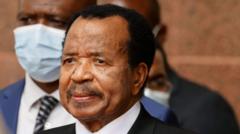Violeta Barrios de Chamorro, who made history as Nicaragua's first woman president after the civil war, died in Costa Rica at 95. Known for her efforts to unify a divided nation, her life reflects the country’s tumultuous political landscape and enduring spirit.
Remembering Violeta Barrios de Chamorro: A Pioneering Leader in Nicaragua's History

Remembering Violeta Barrios de Chamorro: A Pioneering Leader in Nicaragua's History
The first female president of Central America, Violeta Barrios de Chamorro, has passed away at 95, leaving behind a legacy of unity and reconciliation post-civil war.
Violeta Barrios de Chamorro, known for being the first woman president of a Central American nation, has passed away at the age of 95 in her San Jose, Costa Rica apartment. Her son, Pedro Joaquín Chamorro, confirmed the news, noting that she had been in declining health for several years.
Her rise to prominence in Nicaraguan politics was catalyzed by the tragic assassination of her husband, Pedro Joaquín Chamorro, a prominent newspaper editor and critic of both the Sandinista revolutionaries and the Somoza family's dictatorship. Serving as president throughout the 1990s, Barrios de Chamorro presented herself as a unifying figure at a time when Nicaragua was deeply polarized following years of civil unrest.
Despite facing criticism from both sides of the political spectrum, she maintained a reputation as a revered symbol of reconciliation. Public sentiment shifted in her favor over time, and surveys indicated she was one of the most respected figures in Nicaragua, embodying a spirit of forgiveness influenced by her strong Christian values.
Born on October 18, 1929, in Rivas, Nicaragua, to a wealthy lineage tracing back to early Spanish settlers, Barrios de Chamorro's background provided her with the social capital to navigate the political arena effectively. Her death marks the end of a significant chapter in Nicaraguan history, reflected in a lifetime dedicated to serving her country amidst adversity.





















